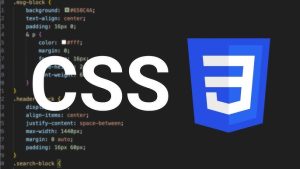Introduction to CSS – Why It Matters
Websites are not just platforms for presenting information—they also need to speak a visual language that engages users. One of the core components of this language is CSS. Short for “Cascading Style Sheets,” CSS controls the style, appearance, and layout of a web page built with HTML. In modern web development, CSS is an essential part of front-end design.
A basic HTML page can present content structurally, but it doesn’t appeal visually. Factors like how long users stay on a page, ease of navigation, and mobile responsiveness are largely influenced by CSS. Thus, CSS is not merely decorative—it is a strategic element that shapes user experience.

The Relationship Between HTML and CSS
HTML and CSS work together to build a web page. HTML forms the structure: headings, paragraphs, images, buttons, and more. CSS adds aesthetics to this structure. For instance, an <h1> tag is added using HTML, but its color, size, and alignment are defined with CSS.
Example:
<h1>Welcome</h1>h1 {
color: darkblue;
font-size: 36px;
text-align: center;
}The Visual Layer of Web Development
Design is just as critical as functionality in modern websites. Users form first impressions in seconds. A professional CSS structure guides users effectively, enhances readability, and conveys the digital identity of a brand. That’s why CSS is more than just styling—it’s a means of communication.
What Does CSS Do?
The primary purpose of CSS is to manage the appearance of websites. Everything from colors and fonts to spacing and borders is controlled with CSS. It also enables centralized style management, simplifying updates and reducing errors.
Centralized Style Management
You can manage the appearance of an entire site through a single CSS file linked to the HTML document. This is especially beneficial in large projects.
<link rel="stylesheet" href="style.css">body {
font-family: 'Open Sans', sans-serif;
background-color: #f7f7f7;
}Maintaining Consistency Across Pages
Using consistent colors, fonts, and button styles across all pages reinforces brand identity. CSS allows for this consistency to be maintained centrally, ensuring a seamless experience as users navigate between pages.
Enhancing User Experience
CSS helps optimize mobile responsiveness, loading speed, readability, and interactive content. It also supports animations and transition effects, offering a more dynamic user experience.
button:hover {
background-color: #007BFF;
color: #fff;
transition: background-color 0.3s ease;
}Core Use Cases of CSS
CSS is not just a tool for decoration. When used correctly, it transforms a website into a platform for superior user experience. It gives you full control over typography, colors, layout, and device compatibility.

Color and Typography Management
Brand colors, fonts, and paragraph structure define a website’s character. CSS allows you to easily adjust text color, weight, alignment, and line spacing.
p {
color: #333;
font-size: 16px;
line-height: 1.5;
text-align: justify;
}Layout and Positioning
Element positioning within a page is managed using properties like float, position, display, and flex. This helps create content hierarchy and a more comprehensible layout.
.container {
display: flex;
justify-content: space-between;
align-items: center;
}Responsive Design
CSS enables you to build designs that dynamically adapt to screen sizes, ensuring proper display across all devices.
@media (max-width: 768px) {
body {
font-size: 14px;
}
}You might also be interested in this article: Ditch White: Use Alternative Colors in Design
Stay updated with our posts and news on Instagram: yazilim.yap
